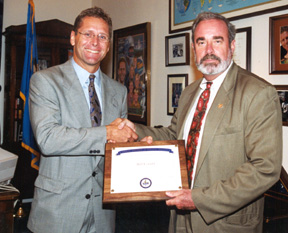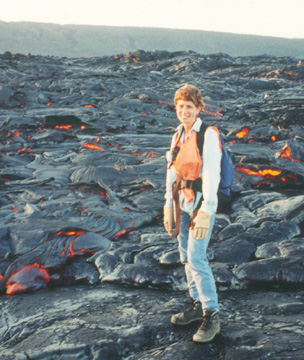Geotimes

Society Page
News
about people and
announcements from
AGI's 39 member societies
______________________ |
To
post news in Society Page, send e-mail to geotimes@agiweb.org
with the subject: Society Page. |
Contents:
AGI celebrates a new relationship …
The American Geological Institute welcomed the American
Rock Mechanics Association (ARMA) as a new member society in November 2001.
Peter Smeallie, executive director of ARMA, says the 300-member organization
is for professionals, researchers and educators interested in rock mechanics
and rock engineering issues, including resource recovery, drilling, excavation
and civil construction.
The society maintains the U.S. membership for the
International Society for Rock Mechanics (ISRM), but Smeallie is quick to point
out that the National Academy of Sciences is the official adherent to the ISRM.
"It was an accident of fate that we maintain the United States membership,"
he says. "The ARMA came into being in 1995 when changes at the National
Academy of Sciences made some of the functions of the rock mechanics community
less than possible to do" - namely, the annual rock mechanics symposium.
Since then, Smeallie has served as executive director.
"We had a lot of volunteers more than willing to help out and about 40
people provided founders fees to get things going." Today, ARMA continues
the 39-year-old tradition of an annual U.S. rock mechanics symposium, which
in 2002 will be held in Toronto as part of the North American rock mechanics
symposium series. "Our principal activity is sharing information. And at
every symposium 400 to 500 people come to share what they are doing."
The symposium is ARMA's primary focus and is successful
largely because ARMA members who belong to other professional societies spread
the word. "We have engineers in the American Society of Civil Engineers,
mining engineers in the Society of Mining Engineers, petroleum engineers in
the Society of Petroleum Engineers, geologists, geophysicists and others,"
Smeallie says.
A hot topic at the symposium is technology. "They
talk about some advance in a new drill bit they are using in petroleum drilling,
and it may have application in hard rock mining." Advances in bore-hole
stability also cross over the different fields. "You want to make sure
when you're drilling a hole that it doesn't collapse. Rocks change as you go
down. If you drill down to a different layer you want to keep the hole straight."
… and embraces another
AGI welcomed the Society of Mineral Museum Professionals
(SMMP) as a new member society in November 2001. Geotimes interviewed SMMP President
Anthony Kampf, curator and department head of Mineral Sciences at the
Natural History Museum of Los Angeles County. Kampf began his current tenure
as president in February 2001 and was previously president from 1989 to 1991.
He has served on the board of directors continuously since 1980. He became a
member of SMMP in 1977, when he started his career as a mineral curator.
 What
are some of the challenges you face in mineral collections? Recent trends
in the mineralogical sciences away from specimen-based studies have led to less
recognition for the basic importance of mineralogical collections. At the same
time, dwindling funding for natural history and science museums has put them
under increasing pressure to justify their function and mission. Addressing
these issues requires museum professionals to communicate more effectively among
themselves and with the public, supporters and those who use their collections.
What
are some of the challenges you face in mineral collections? Recent trends
in the mineralogical sciences away from specimen-based studies have led to less
recognition for the basic importance of mineralogical collections. At the same
time, dwindling funding for natural history and science museums has put them
under increasing pressure to justify their function and mission. Addressing
these issues requires museum professionals to communicate more effectively among
themselves and with the public, supporters and those who use their collections.
What are your thoughts on the
importance of mineral collections to the nation? Mineral collections
certainly serve as sources of material for scientific research. In many cases
they are the only practical sources, especially in the case of "extinct"
localities. Mineral collections are also educational resources, both for teaching
and for public displays. Mineral exhibits typically rely on aesthetic specimens
to attract attention, while transmitting didactic information on mineral diversity,
properties, formation, uses, etc. The importance of minerals as the raw materials
of modern civilization cannot be overstated. Unfortunately, in mineral exhibits
this point is often woefully understated, if it is stated at all.
Anthony Kampf in Minas
Gerais, Brazil
Courtesy of A. Kampf
What do you find most exciting
about mineral museums? I get my greatest charge from witnessing the
reactions of people, especially children, when they see beautiful mineral specimens
for the first time and then realize that they are products of nature. The fascination
that minerals hold for many people, myself included, can be very powerful and
empowering when it is channeled toward gaining a better understanding of the
world around us.
AAPG thanks Hill geoscientists
The American Association of Petroleum Geologists
(AAPG) recognized John Rishel, legislative staffer, and Bill Condit,
staff director, both of the House Subcommittee on Energy and Mineral Resources,
for their efforts to involve geoscience in the nation's energy debate. "John
was instrumental in getting several members of AAPG to testify before the committee
over the last year and a half," says Don O'Nesky, AAPG deputy executive
director. Rep. Steve Largent (R-Okla.), in whose congressional district AAPG
is located, presented Rishel and Condit with the AAPG certificates of appreciation.
 Rep.
Steve Largent (R-Okla.), left, gives Bill Condit, staff director of the House
Subcommittee on Energy and Mineral Resources, the AAPG award.
Rep.
Steve Largent (R-Okla.), left, gives Bill Condit, staff director of the House
Subcommittee on Energy and Mineral Resources, the AAPG award.
Courtesty of AAPG
Both Condit and Rishel are geoscientists.
"When you have people in science working in government, it makes it easier
to bring scientists into government politics, a crucial issue for our profession,"
says Lee Gerhard, principal geologist of the Kansas Geological Survey and chair
of the AAPG government affairs committee. "What they have done is help
create the opportunity for AAPG members to present testimony on the pressing
national issue of energy supply for the future, something that has been difficult
to do before. Far too much federal policy is made without geological information
so that the resulting policy is frequently flawed and does not take into account
geologic processes, geologic rates and geologic controls."
New face on the masthead
Margaret Mangan, a volcanologist with the
U.S. Geological Survey (USGS) and a member of the Geological Society of America
and American Geophysical Union (AGU), joins the editors-in-chief
team of AGU's Journal of Volcanology and Geothermal Research on Jan. 1. She
is replacing Greg Valentine, who is stepping down from the editorial position
after eight years.
 Mangan accepted the editorial responsibilities based on her desire to help encourage
young women in the geosciences and on her commitment to help communicate earth
science. "Before anything is submitted, part of the role of the editor
is to seek out submissions," she says. As an editor, Mangan looks forward
to the opportunity to teach young scientists and especially women early in their
careers how to better communicate their work and highlight important aspects
of a journal article.
Mangan accepted the editorial responsibilities based on her desire to help encourage
young women in the geosciences and on her commitment to help communicate earth
science. "Before anything is submitted, part of the role of the editor
is to seek out submissions," she says. As an editor, Mangan looks forward
to the opportunity to teach young scientists and especially women early in their
careers how to better communicate their work and highlight important aspects
of a journal article.
Mangan will be one of five editors-in-chief in charge
of manuscript submissions and reviews. "The basic job of the editors is
setting science policy for the journal, managing the peer review process and
being responsible for the acceptance and rejection of individual papers,"
she says. Mangan has worked with the USGS since 1983 and is currently based
in Menlo Park, Calif. Prior to that, she was stationed at the Hawaii Volcano
Observatory from 1990 to 1998. When she moved from Hawaii to California, she
switched from studying active volcanoes to doing experiments using high temperatures
and pressures.
Margaret Mangan
at Kilauea Volcano.
Courtesy of M. Mangan
Associate Editor Christina Reed writes the Society
Page.
 What
are some of the challenges you face in mineral collections? Recent trends
in the mineralogical sciences away from specimen-based studies have led to less
recognition for the basic importance of mineralogical collections. At the same
time, dwindling funding for natural history and science museums has put them
under increasing pressure to justify their function and mission. Addressing
these issues requires museum professionals to communicate more effectively among
themselves and with the public, supporters and those who use their collections.
What
are some of the challenges you face in mineral collections? Recent trends
in the mineralogical sciences away from specimen-based studies have led to less
recognition for the basic importance of mineralogical collections. At the same
time, dwindling funding for natural history and science museums has put them
under increasing pressure to justify their function and mission. Addressing
these issues requires museum professionals to communicate more effectively among
themselves and with the public, supporters and those who use their collections.
 Rep.
Steve Largent (R-Okla.), left, gives Bill Condit, staff director of the House
Subcommittee on Energy and Mineral Resources, the AAPG award.
Rep.
Steve Largent (R-Okla.), left, gives Bill Condit, staff director of the House
Subcommittee on Energy and Mineral Resources, the AAPG award. Mangan accepted the editorial responsibilities based on her desire to help encourage
young women in the geosciences and on her commitment to help communicate earth
science. "Before anything is submitted, part of the role of the editor
is to seek out submissions," she says. As an editor, Mangan looks forward
to the opportunity to teach young scientists and especially women early in their
careers how to better communicate their work and highlight important aspects
of a journal article.
Mangan accepted the editorial responsibilities based on her desire to help encourage
young women in the geosciences and on her commitment to help communicate earth
science. "Before anything is submitted, part of the role of the editor
is to seek out submissions," she says. As an editor, Mangan looks forward
to the opportunity to teach young scientists and especially women early in their
careers how to better communicate their work and highlight important aspects
of a journal article. 